HAZARD AND PRECAUTIONARY STATEMENTS

(There are 72 individual and 17 combined Hazard statements)
| H200 | Unstable explosives. |
| H201 | Explosive; mass explosion hazard. |
| H202 | Explosive, severe projection hazard. |
| H203 | Explosive; fire, blast or projection hazard. |
| H204 | Fire or projection hazard. |
| H205 | May mass explode in fire. |
| H220 | Extremely flammable gas. |
| H221 | Flammable gas. |
| H222 | Extremely flammable aerosol. |
| H223 | Flammable aerosol. |
| H224 | Extremely flammable liquid and vapour. |
| H225 | Highly flammable liquid and vapour. |
| H226 | Flammable liquid and vapour. |
| H227 | Combustible liquid. |
| H228 | Flammable solid. |
| H240 | Heating may cause an explosion. |
| H241 | Heating may cause a fire or explosion. |
| H242 | Heating may cause a fire. |
| H250 | Catches fire spontaneously if exposed to air. |
| H251 | Self-heating: may catch fire. |
| H252 | Self-heating in large quantities; may catch fire. |
| H260 | In contact with water releases flammable gases which may ignite spontaneously. |
| H261 | In contact with water releases flammable gas. |
| H270 | May cause or intensify fire; oxidizer. |
| H271 | May cause fire or explosion; strong oxidizer. |
| H272 | May intensify fire; oxidizer. |
| H280 | Contains gas under pressure; may explode if heated. |
| H281 | Contains refrigerated gas; may cause cryogenic burns or injury. |
| H290 | May be corrosive to metals. |
| H400 | Very toxic to aquatic life. |
| H401 | Toxic to aquatic life. |
| H402 | Harmful to aquatic life. |
| H410 | Very toxic to aquatic life with long lasting effects. |
| H411 | Toxic to aquatic life with long lasting effects. |
| H412 | Harmful to aquatic life with long lasting effects. |
| H413 | May cause long lasting harmful effects to aquatic life. |
| H420 | Harms public health and the environment by destroying ozone in the upper atmospere. |
| EUH001 | Explosive when dry. |
| EUH006 | Explosive with or without contact with air. |
| EUH014 | Reacts violently with water. |
| EUH018 | In use may form flammable/explosive vapour-air mixture. |
| EUH018a | In use may form explosive vapour-air mixture. |
| EUH018b | In use may form flammable vapour-air mixture. |
| EUH019 | May form explosive peroxides. |
| EUH029 | Contact with water liberates toxic gas. |
| EUH030 | Can become highly flammable in use. |
| EUH031 | Contact with acids liberates toxic gas. |
| EUH032 | Contact with acids liberates very toxic gas. |
| EUH044 | Risk of explosion if heated under confinement. |
| EUH059 | Hazardous to the ozone layer. |
| EUH066 | Repeated exposure may cause skin dryness or cracking. |
| EUH070 | Toxic by eye contact. |
| EUH071 | Corrosive to the respiratory tract. |
| EUH201 | Contains lead. Should not be used on surfaces liable to be chewed or sucked by children. Warning! Contains lead. |
| EUH201A | Warning! Contains lead. |
| EUH202 | Cyanoacrylate. Danger. Bonds skin and eyes in seconds. Keep out of the reach of children. |
| EUH203 | Contains chromium (VI). May produce an allergic reaction. |
| EUH204 | Contains isocyanates. See information supplied by the manufacturer. |
| EUH205 | Contains epoxy constituents. See information supplied by the manufacturer. |
| EUH206 | Warning! Do not use together with other products. May release dangerous gases (chlorine). |
| EUH207 | Warning! Contains cadmium. Dangerous fumes are formed during use. See information supplied by the manufacturer. Comply with the safety instructions. |
| EUH207-EG | Warning! Contains cadmium. Dangerous fumes are formed during use. See information supplied by the manufacturer. Comply with the safety instructions. |
| EUH208 | Contains (name of sensitising substance). May produce an allergic reaction. |
| EUH208-EG | Contains (name of sensitising substance). May produce an allergic reaction. |
| EUH209 | Can become highly flammable in use. |
| EUH209a | Can become highly flammable in use. |
| EUH209b | Can become flammable in use. |
| EUH209A | Can become flammable in use. |
| EUH210 | Safety data sheet available on request. |
| EUH401 | To avoid risks to human health and the environment, comply with the instructions for use. |
(There are 116 individual and 33 combined Precautionary statements)
P101 If medical advice is needed,have product container or label at hand.
P102 Keep out of reach of children.
P103 Read label before use
P201 Obtain special instructions before use.
P202 Do not handle until all safety precautions have been read and understood.
P210 Keep away from heat/sparks/open flames/hot surfaces. — No smoking.
P211 Do not spray on an open flame or other ignition source.
P220 Keep/Store away from clothing/…/combustible materials.
P221 Take any precaution to avoid mixing with combustibles/…
P222 Do not allow contact with air.
P223 Keep away from any possible contact with water, because of violent reaction and possible flash fire.
P230 Keep wetted with …
P231 Handle under inert gas.
P232 Protect from moisture.
P233 Keep container tightly closed.
P234 Keep only in original container.
P235 Keep cool.
P240 Ground/bond container and receiving equipment.
P241 Use explosion-proof electrical/ventilating/lighting/…/equipment.
P242 Use only non-sparking tools.
P243 Take precautionary measures against static discharge.
P244 Keep reduction valves free from grease and oil.
P250 Do not subject to grinding/shock/…/friction.
P251 Pressurized container: Do not pierce or burn, even after use.
P260 Do not breathe dust/fume/gas/mist/vapours/spray.
P261 Avoid breathing dust/fume/gas/mist/vapours/spray.
P262 Do not get in eyes, on skin, or on clothing.
P263 Avoid contact during pregnancy/while nursing.
P264 Wash hands thoroughly after handling.
P264 Wash skin thouroughly after handling.
P270 Do not eat, drink or smoke when using this product.
P271 Use only outdoors or in a well-ventilated area.
P272 Contaminated work clothing should not be allowed out of the workplace.
P273 Avoid release to the environment.
P280 Wear protective gloves/protective clothing/eye protection/face protection.
P281 Use personal protective equipment as required.
P282 Wear cold insulating gloves/face shield/eye protection.
P283 Wear fire/flame resistant/retardant clothing.
P284 Wear respiratory protection.
P285 In case of inadequate ventilation wear respiratory protection.
P231+P232 Handle under inert gas. Protect from moisture.
P235+P410 Keep cool. Protect from sunlight.
P301 IF SWALLOWED:
P304 IF INHALED:
P305 IF IN EYES:
P306 IF ON CLOTHING:
P307 IF exposed:
P308 IF exposed or concerned:
P309 IF exposed or if you feel unwell:
P310 Immediately call a POISON CENTER or doctor/physician.
P311 Call a POISON CENTER or doctor/physician.
P312 Call a POISON CENTER or doctor/physician if you feel unwell.
P313 Get medical advice/attention.
P314 Get medical advice/attention if you feel unwell.
P315 Get immediate medical advice/attention.
P320 Specific treatment is urgent (see … on this label).
P321 Specific treatment (see … on this label).
P322 Specific measures (see …on this label).
P330 Rinse mouth.
P331 Do NOT induce vomiting.
P332 IF SKIN irritation occurs:
P333 If skin irritation or rash occurs:
P334 Immerse in cool water/wrap n wet bandages.
P335 Brush off loose particles from skin.
P336 Thaw frosted parts with lukewarm water. Do not rub affected area.
P337 If eye irritation persists:
P338 Remove contact lenses, if present and easy to do. Continue rinsing.
P340 Remove victim to fresh air and keep at rest in a position comfortable for breathing.
P341 If breathing is difficult, remove victim to fresh air and keep at rest in a position comfortable for breathing.
P342 If experiencing respiratory symptoms:
P350 Gently wash with plenty of soap and water.
P351 Rinse cautiously with water for several minutes.
P352 Wash with plenty of soap and water.
P353 Rinse skin with water/shower.
P360 Rinse immediately contaminated clothing and skin with plenty of water before removing clothes.
P361 Remove/Take off immediately all contaminated clothing.
P362 Take off contaminated clothing and wash before reuse.
P363 Wash contaminated clothing before reuse.
P370 In case of fire:
P371 In case of major fire and large quantities:
P372 Explosion risk in case of fire.
P373 DO NOT fight fire when fire reaches explosives.
P374 Fight fire with normal precautions from a reasonable distance.
P376 Stop leak if safe to do so. Oxidising gases (section 2.4) 1
P377 Leaking gas fire: Do not extinguish, unless leak can be stopped safely.
P378 Use … for extinction.
P380 Evacuate area.
P381 Eliminate all ignition sources if safe to do so.
P390 Absorb spillage to prevent material damage.
P391 Collect spillage. Hazardous to the aquatic environment
P301+P310 IF SWALLOWED: Immediately call a POISON CENTER or doctor/physician.
P301+P312 IF SWALLOWED: call a POISON CENTER or doctor/physician IF you feel unwell.
P301+P330+P331 IF SWALLOWED: Rinse mouth. Do NOT induce vomiting.
P302+P334 IF ON SKIN: Immerse in cool water/wrap in wet bandages.
P302+P350 IF ON SKIN: Gently wash with plenty of soap and water.
P302+P352 IF ON SKIN: wash with plenty of soap and water.
P303+P361+P353 IF ON SKIN (or hair): Remove/Take off Immediately all contaminated clothing. Rinse SKIN with water/shower.
P304+P312 IF INHALED: Call a POISON CENTER or doctor/physician if you feel unwell.
P304+P340 IF INHALED: Remove victim to fresh air and Keep at rest in a position comfortable for breathing.
P304+P341 IF INHALED: If breathing is difficult, remove victim to fresh air and keep at rest in a position comfortable for breathing.
P305+P351+P338
P306+P360 IF ON CLOTHING: Rinse Immediately contaminated CLOTHING and SKIN with plenty of water before removing clothes.
P307+P311 IF exposed: call a POISON CENTER or doctor/physician.
P308+P313 IF exposed or concerned: Get medical advice/attention.
P309+P311 IF exposed or if you feel unwell: call a POISON CENTER or doctor/physician.
P332+P313 IF SKIN irritation occurs: Get medical advice/attention.
P333+P313 IF SKIN irritation or rash occurs: Get medical advice/attention.
P335+P334 Brush off loose particles from skin. Immerse in cool water/wrap in wet bandages.
P337+P313 IF eye irritation persists: Get medical advice/attention.
P342+P311 IF experiencing respiratory symptoms: call a POISON CENTER or doctor/physician.
P370+P376 in case of fire: Stop leak if safe to Do so.
P370+P378 In case of fire: Use … for extinction.
P370+P380 in case of fire: Evacuate area.
P370+P380+P375 in case of fire: Evacuate area. Fight fire remotely due to the risk of explosion.
P371+P380+P375 in case of major fire and large quantities: Evacuate area. Fight fire remotely due to the risk of explosion.
P401 Store …
P402 Store in a dry place.
P403 Store in a well-ventilated place.
P404 Store in a closed container.
IF IN EYES: Rinse cautiously with water for several minutes. Remove contact lenses, if present and easy to do. Continue rinsing.
P405 Store locked up.
P406 Store in corrosive resistant/… container with a resistant inner liner.
P407 Maintain air gap between stacks/pallets.
P410 Protect from sunlight.
P411 Store at temperatures not exceeding … oC/…oF.
P412 Do not expose to temperatures exceeding 50 oC/ 122 oF.
P413 Store bulk masses greater than … kg/…lbs at temperatures not exceeding … oC/…oF.
P420 Store away from other materials.
P422 Store contents under …
P402+P404 Store in a dry place. Store in a closed container.
P403+P233 Store in a well-ventilated place. Keep container tightly closed.
P403+P235 Store in a well-ventilated place. Keep cool.
P410+P403 Protect from sunlight. Store in a well-ventilated place.
P410+P412 Protect from sunlight. Do not expose to temperatures exceeding 50 oC/122oF.
P411+P235 Store at temperatures not exceeding … oC/…oF. Keep cool.
P501 Dispose of contents/container to..…
P502 Refer to manufacturer/supplier for information on recovery/recycling
Compared to the current EU system the most noticeable change are the pictograms (formerly: hazard symbols). While the most of the GHS pictograms
have an equivalent in the old system, the pictograms GHS 04, GHS 07 and GHS 08 are completely new.
The GHS System is built on 16 physical, 10 health and 3 environmental hazard classes and comprises the following communication elements:
| Description | Pictogram | Hazard class and hazard category: |
| Exploding Bomb GHS01 |
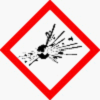 |
Unstable explosives Explosives of Divisions 1.1, 1.2, 1.3, 1.4 Self reactive substances and mixtures, Types A,B Organic peroxides, Types A,B |
| Flame GHS02 |
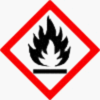 |
Flammable gases, category 1 Flammable aerosols, categories 1,2 Flammable liquids, categories 1,2,3 Flammable solids, categories 1,2 Self-reactive substances and mixtures, Types B,C,D,E,F Pyrophoric liquids, category 1 Pyrophoric solids, category 1 Self-heating substances and mixtures, categories 1,2 Substances and mixtures, which in contact with water, emit flammable gases, categories 1,2,3 Organic peroxides, Types B,C,D,E,F |
| Flame Over Circle GHS03 |
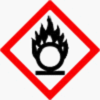 |
Oxidizing gases, category 1 Oxidizing liquids, categories 1,2,3 |
| Gas Cylinder GHS04 |
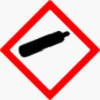 |
Gases under pressure: - Compressed gases - Liquefied gases - Refrigerated liquefied gases - Dissolved gases |
| Corrosion GHS05 |
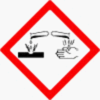 |
Corrosive to metals, category 1 Skin corrosion, categories 1A,1B,1C Serious eye damage, category 1 |
| Skull and Crossbones GHS06 |
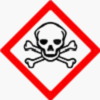 |
Acute toxicity (oral, dermal, inhalation), categories 1,2,3 |
| Exclamation Mark GHS07 |
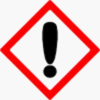 |
Acute toxicity (oral, dermal, inhalation), category 4 Skin irritation, category 2 Eye irritation, category 2 Skin sensitisation, category 1 Specific Target Organ Toxicity – Single exposure, category 3 |
| Health Hazard GHS08 |
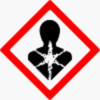 |
Respiratory sensitization, category 1 Germ cell mutagenicity, categories 1A,1B,2 Carcinogenicity, categories 1A,1B,2 Reproductive toxicity, categories 1A,1B,2 Specific Target Organ Toxicity – Single exposure, categories 1,2 Specific Target Organ Toxicity – Repeated exposure, categories 1,2 Aspiration Hazard, category 1 |
| Environment GHS09 |
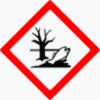 |
Hazardous to the aquatic environment - Acute hazard, category1 - Chronic hazard, categories 1,2 |